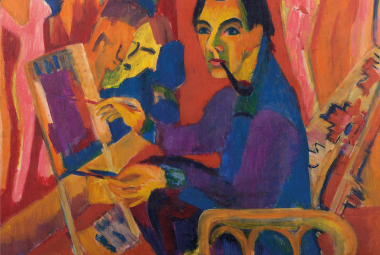Jannes de Vries
Meppel 1901 - Groningen 1986
Early years
At the age of fifteen, Jannes de Vries became the youngest clerk at a law firm in Meppel. His father did not consider it useful to train as a visual artist, but his employer thought otherwise. He offered him the financial opportunities to study at the ‘Rijknormaalschool voor Tekenleraren’ in Amsterdam. He left for the capital in 1920 and completed his education in 1922. After briefly teaching in his hometown of Meppel, he left for Paris in 1923 where he enrolled in the rather traditional École Nationale Supérieur des Beaux Arts. After spending several months in Paris, he left in the spring of 1923 via Clermont-Ferrand for Florence and Rome. With a detour via the Lipari, Palermo and Tunisia he traveled back to the Netherlands in 1924. North Africa in particular made a deep impression on him. Jannes de Vries would return there regularly later in his life. Tunisia and Morocco inspired him to high points in his work, including his Biblical drawings and paintings.

Teacher and designer
In 1925 he started as a drawing teacher at the Stedelijk Gymnasium (now Praedinius Gymnasium) in Groningen, where he would remain until his retirement in 1966. In the same year he became a member of De Ploeg, even chaired the company in 1926, but canceled his membership in 1927. The reasons for this are unclear. He himself said that he felt a strange bird in De Ploeg, but on the other hand he always felt comfortable with dissenters. It may be that his work as a teacher and busy family life took so much of his time to dedicate himself fully to painting and drawing. Perhaps it was also because his still traditionally tinted work did not fit in well with the mostly expressionist and brightly coloured work of De Ploeg. However, he kept in touch with the other Ploeg members.
To supplement his income, he started making advertisements, illustrations and designs during these years. His design agency was very successful. A well-known design by his hand is the logo for Tjoklat chocolate. His busy work allowed him only to paint and draw during school holidays. In the 1930s he made a number of beautiful landscape paintings of landscapes Drenthe and Groningen. Remarkably, in those years his work became more expressionistic.
In the 1950s and especially after his retirement as a drawing teacher in 1966, Jannes de Vries started painting, drawing and making watercolours fulltime again. The number of exhibitions of his work increased, including retrospective exhibitions; they show how much his work was, and still is, appreciated. He also became a member of De Ploeg again during these years. In 1970 he received the cultural prize from the province of Groningen.

Inspiration
Jannes de Vries drew his inspiration from his travels to France, Switzerland, Italy and North Africa, among others. But the Groningen countryside was and remained one of his main sources of inspiration. The space and the light fascinated him immensely. He considered staying on the ‘Groninger Hogeland’ as his best trip. He traversed the province by train and bicycle and sketched and painted ‘en plein air’. In the twenty years after 1966 until his death he was incredibly productive and his work takes on an expressionistic dynamism and an almost screaming colour scheme that reminds of the early years of De Ploeg. According to Johan Dijkstra, Jannes de Vries was more of a Ploeg painter from the last than the first hour.
Literature
Text: Jan Willem Drijvers
Francis van Dijk, Jannes de Vries. Met bijdragen van Cees Hofsteenge, Han Drijvers, W. Jos de Gruyter, Pieter Huizinga en Henk van Os, Groningen: SBBKG 2004. Han Drijvers & Henk van Os, Jannes de Vries 1901-1986, Bedum 1989. Cees Hofsteenge, De Ploeg 1918-1941. De Hoogtijdagen, Groningen: Benjamin & Partners 1993. Elise van Ditmars (ed.), Jannes de Vries, 1901-1986, Catalogue Exhibition Veenkoloniaal Museum te Veendam, 2000.
